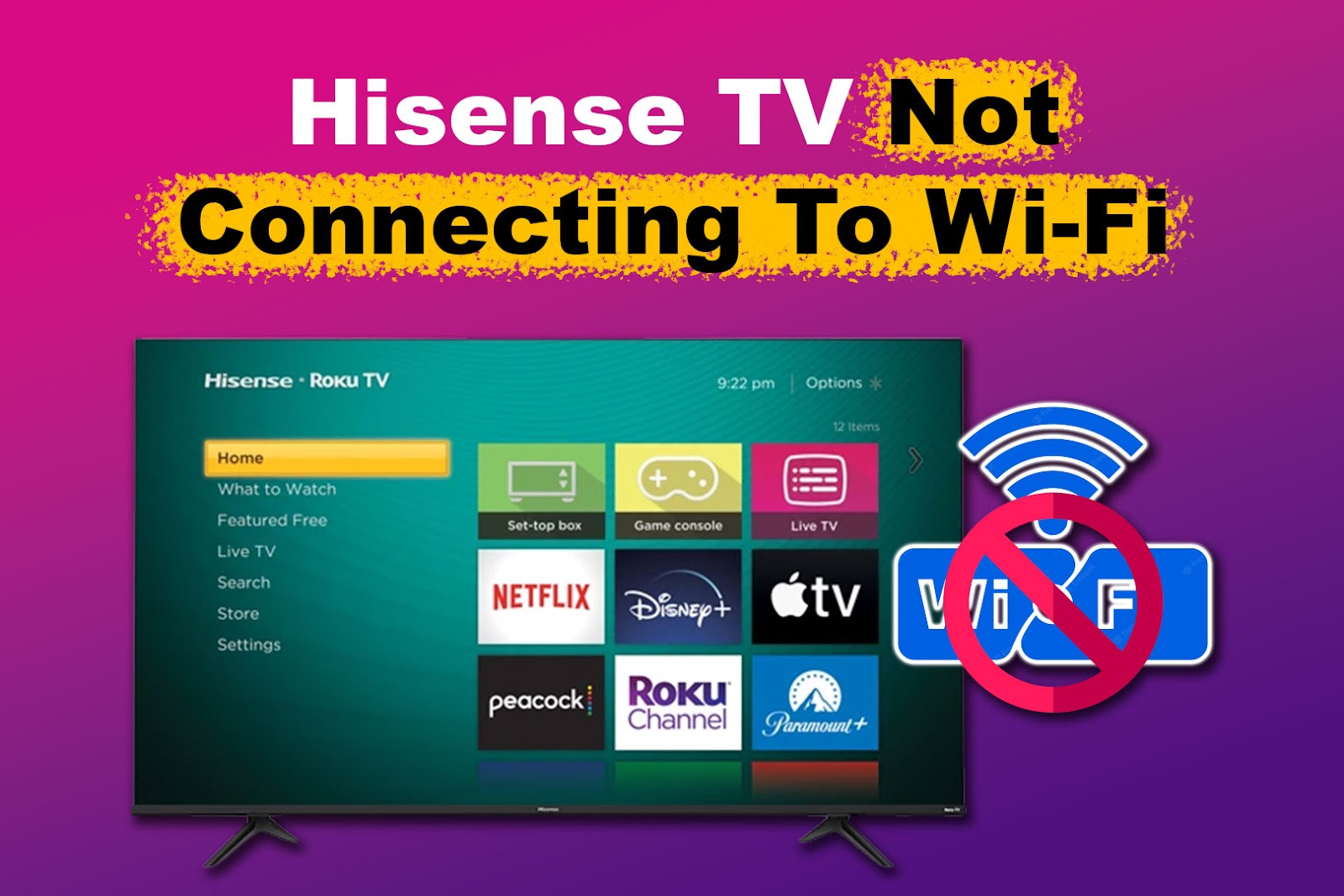Struggling to connect your Hisense Roku TV to WiFi? You’re not alone.
Many users face this issue. Connectivity problems can be frustrating. A reliable internet connection is essential for streaming. Without it, your TV experience can suffer. Understanding common reasons for WiFi issues can help. This guide explores potential causes and solutions.
From router placement to software glitches, we cover it all. Fixing these problems can be simpler than you think. Ready to troubleshoot and enjoy uninterrupted streaming? Let’s dive in and solve your WiFi woes.
Common Connection Issues
Experiencing connection issues with your Hisense Roku TV can be frustrating. Many users face common problems when trying to connect their TV to WiFi. This section will help you understand these issues and how to resolve them.
Identifying The Problem
The first step in resolving WiFi connection issues is identifying the problem. Your TV may not be connecting to the WiFi for several reasons. Here’s how you can check:
- Ensure your router is working. Check if other devices can connect.
- Check the network settings on your TV. Make sure they are correct.
- Restart your router and TV. Sometimes, a simple restart can fix the issue.
Signal Interference
Signal interference can also cause connectivity issues. Several factors can interfere with your WiFi signal:
- Other electronic devices can disrupt the signal.
- Walls and floors can weaken the signal strength.
- Distance from the router to the TV matters. The further away, the weaker the signal.
To improve the connection:
- Place your router closer to your TV.
- Avoid placing other electronic devices near your router.
- Use a WiFi extender to boost the signal strength.
Dealing with these common issues can help you get your Hisense Roku TV back online and enjoy a seamless streaming experience.

Credit: www.youtube.com
Restarting Your Hisense Roku Tv
Restarting your Hisense Roku TV can resolve WiFi connectivity issues. Simply unplug the TV, wait a few seconds, and plug it back in. This often helps restore the connection.
Struggling to connect your Hisense Roku TV to WiFi? Restarting the TV can often resolve this issue. Restarting helps clear temporary glitches and refreshes the system. Follow these steps to give your TV a fresh start.Power Cycle Steps
First, turn off your Hisense Roku TV. Unplug it from the power outlet. Wait at least 60 seconds. During this time, press and hold the power button for 30 seconds. Plug the TV back into the power outlet. Turn the TV back on and check your WiFi connection.Resetting Network Settings
Navigate to the settings menu on your Hisense Roku TV. Select “Network” from the list. Choose “Reset Network Settings.” Confirm your selection to reset all network settings. After the reset, reconnect to your WiFi network. Enter the correct password. This process will refresh your network settings and may solve connection issues. “`Checking Wifi Network
One common issue with Hisense Roku TVs is not connecting to WiFi. To resolve this, start by checking your WiFi network. Several factors can affect the connection, such as router placement and network congestion. Let’s delve into these aspects in detail.
Router Placement
The placement of your router plays a significant role in WiFi connectivity. Ensure your router is in a central location. This helps distribute the signal evenly throughout your home. Avoid placing it near walls, floors, or metal objects. These can interfere with the signal.
Also, try to place the router on a higher shelf. Signals travel better when the router is elevated. If your TV is far from the router, consider using a WiFi extender. This device boosts the signal strength, ensuring better connectivity for your Hisense Roku TV.
Network Congestion
Network congestion occurs when too many devices use the same WiFi network. This can slow down your internet speed. To check for network congestion, disconnect unnecessary devices from the WiFi. Devices like smartphones, tablets, and laptops can clog the network.
You can also check your router’s admin settings. Most routers have a Quality of Service (QoS) setting. This allows you to prioritize certain devices, like your Hisense Roku TV, over others. By doing this, you can ensure a stable connection for your TV.
If network congestion persists, consider upgrading your internet plan. Some internet plans offer higher bandwidth. This can handle more devices without slowing down. Investing in a dual-band router can also help. It provides two separate networks, reducing congestion.
| Action | Effect |
|---|---|
| Central router placement | Even signal distribution |
| Elevated router position | Better signal travel |
| Using WiFi extender | Boosts signal strength |
| Disconnecting devices | Reduces network congestion |
| Prioritizing devices (QoS) | Stable connection for TV |
| Upgrading internet plan | Handles more devices |
| Dual-band router | Reduces congestion |
Updating Firmware
Experiencing issues with your Hisense Roku TV not connecting to WiFi? One effective solution might be updating the firmware. Firmware updates can improve the TV’s performance, fix bugs, and ensure compatibility with new features. Here’s how you can update the firmware on your Hisense Roku TV.
Checking For Updates
First, ensure your TV is connected to the internet. Then follow these steps:
- Press the Home button on your Roku remote.
- Navigate to Settings.
- Select System.
- Choose System Update.
- Click on Check Now to see if updates are available.
Installing Updates
If updates are available, follow these steps to install them:
- After checking for updates, you will see an Update Available message.
- Select Update Now.
- Your TV will start downloading the update.
- Once downloaded, the TV will automatically install the update.
- After installation, the TV will restart.
Keep your TV powered on during the update process to avoid issues.
Updating the firmware can solve many connectivity issues. Ensure your Hisense Roku TV is always up-to-date for the best performance.
Reconfiguring Network Settings
Reconfiguring network settings can solve many connectivity issues with your Hisense Roku TV. It often helps to tweak certain settings to ensure a stable connection. Follow these steps to get your TV back online.
Manual Ip Setup
First, you need to set up a manual IP address. Go to the network settings on your Hisense Roku TV. Select ‘Manual setup’ and enter an IP address. Make sure the IP address is unique within your network. For instance, if your router uses 192.168.1.1, try 192.168.1.50. Enter the subnet mask, usually 255.255.255.0.
Next, enter the gateway, which is the IP address of your router. This is often 192.168.1.1. Finally, save these settings and check if your TV connects to the wifi.
Dns Server Settings
Changing the DNS settings can also help. Go to the network settings and select ‘Manual setup.’ Enter the primary DNS server. You can use a public DNS like Google’s 8.8.8.8. For the secondary DNS, use 8.8.4.4. Save the settings and test your connection.
Sometimes, your ISP’s DNS might be slow. Using a different DNS can improve your connectivity. Follow these steps to see if your connection improves.

Credit: alvarotrigo.com
Advanced Troubleshooting
Having trouble with your Hisense Roku TV not connecting to WiFi? Don’t worry. Advanced troubleshooting can help resolve the issue. Sometimes, basic fixes are not enough. This guide provides detailed steps to get your TV back online.
Factory Reset
A factory reset can solve many issues. It returns your TV to its original settings. Before doing this, note that you will lose all your custom settings. Here’s how to do it:
- Press the Home button on your remote.
- Go to Settings.
- Select System.
- Choose Advanced system settings.
- Select Factory reset.
- Follow the on-screen instructions.
After the reset, try connecting to WiFi again. This often resolves connectivity issues.
Contacting Support
If a factory reset does not work, contacting support is the next step. Hisense customer support can provide expert help. Make sure to have your TV model number and purchase details ready. This information will help speed up the process.
You can reach Hisense support through their website or customer service hotline. Explain your issue clearly. They may guide you through additional troubleshooting steps. Sometimes, they might need to send a technician for a more detailed check.
Remember, professional help is always available. Don’t hesitate to use it if needed.
Optimizing Wifi Signal
Experiencing trouble connecting your Hisense Roku TV to WiFi can be frustrating. A weak WiFi signal often causes this issue. Optimizing your WiFi signal can improve connectivity and streaming quality.
Using A Wifi Extender
A WiFi extender can help boost your signal strength. Place the extender halfway between your router and TV. This position allows the extender to receive a strong signal and relay it effectively. Ensure the extender is in an open area, free from obstructions. This placement minimizes interference and maximizes signal strength.
Switching Channels
WiFi routers operate on different channels. Congestion on a channel can slow your connection. Switching channels can reduce this congestion. Access your router settings through a web browser. Look for the channel setting under the wireless settings menu. Try different channels to find the least congested one. This simple step can significantly improve your WiFi performance.

Credit: www.ytechb.com
Alternative Connection Methods
Sometimes, your Hisense Roku TV may face issues connecting to Wi-Fi. In such cases, it’s essential to explore alternative connection methods. These methods can provide a stable and reliable connection, ensuring you continue to enjoy your favorite content without interruptions.
Ethernet Cable Connection
One of the most reliable ways to connect your Hisense Roku TV is using an Ethernet cable connection. This method offers a stable and fast internet connection, reducing the chances of buffering or disconnection.
| Step | Instructions |
|---|---|
| 1 | Locate the Ethernet port on the back of your Hisense Roku TV. |
| 2 | Connect one end of the Ethernet cable to the TV’s Ethernet port. |
| 3 | Connect the other end to your router or modem. |
| 4 | Turn on your TV and navigate to Settings > Network. |
| 5 | Select “Wired (Ethernet)” to establish the connection. |
Using an Ethernet cable ensures a direct connection to your network, which is often more stable than Wi-Fi.
Mobile Hotspot
If you don’t have access to an Ethernet cable, using a mobile hotspot can be a viable alternative. This method allows your TV to connect to the internet through your smartphone’s data connection.
- Enable the mobile hotspot feature on your smartphone.
- On your Hisense Roku TV, go to Settings > Network.
- Select “Wireless (Wi-Fi)” and wait for the TV to scan for available networks.
- Choose your mobile hotspot from the list of networks.
- Enter the password for your hotspot and connect.
Using a mobile hotspot can be a convenient temporary solution. However, it may consume a lot of data, so be mindful of your data plan limits.
Frequently Asked Questions
Why Won’t My Hisense Roku Tv Connect To Wifi?
Your Hisense Roku TV may not connect due to weak signal or incorrect password. Check your WiFi settings.
How Do I Reset The Network On My Hisense Roku Tv?
Go to Settings > System > Advanced system settings > Network connection reset. This will reset your network settings.
What Should I Do If My Wifi Password Is Correct But Still Not Connecting?
Restart your router and TV. Double-check the password and ensure your TV is within range of the router.
Can Interference Cause Wifi Issues With Hisense Roku Tv?
Yes, other devices or thick walls can cause interference. Try moving your router closer to the TV.
How Do I Update The Firmware On My Hisense Roku Tv?
Go to Settings > System > System update > Check now. Follow the prompts to update your firmware.
Conclusion
Fixing your Hisense Roku TV’s WiFi connection is possible with patience. Follow the steps mentioned. Check your router settings. Restart your TV and router. Ensure your TV firmware is updated. Contact customer support if issues persist. Reliable WiFi ensures seamless streaming.
Enjoy your favorite shows without interruptions. Thanks for reading!





